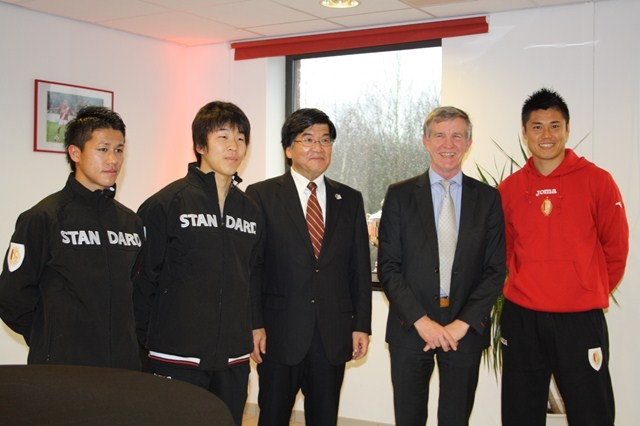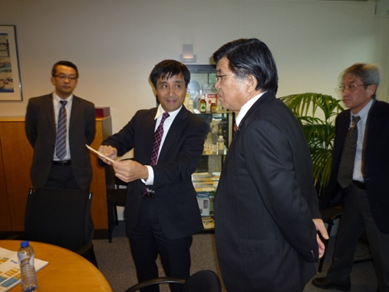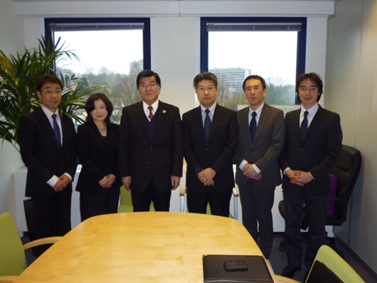Another Side to the Japanese Ambassador in Belgium (No.8)
One of my hobbies is “Statistics watching”. When I have the time, I take a long look at various statistics without getting bored. Though it is only an enumeration of numbers, I can see another world, different from the stereotypes, by using my imagination. The other day, I looked up the OECD country statistics on the Internet and checked the similarities and differences between Japan and Belgium by comparing their demographics. The Japanese population has decreased since 2006, but the Belgian population is increasing even now. The proportion of the population under the age of 15 is 13% in Japan against 16% in Belgium. On the other hand, the proportion of the population above the age of 65 is 23.1% in Japan against only 17.6% in Belgium. The aging society seems to be progressing considerably in Japan. In addition, the ratio of foreigners has been about 1.5% for the past 10 years against 9.8% in Belgium. Moreover, this percentage is increasing in Belgium year by year, which shows a multinational society in progress. By the way, the OECD statistics list also the overall annual working hours and we can check through these figures the view of some that Belgians do not work so much. The annual working hours in Japan are 1773 hours and those of Belgium are 1551. Putting Saturday and Sunday at holidays, the Japanese thus work 34 hours a week and the Belgians 30 hours a week. The conclusion seems to be that the Belgians do not work so much indeed, but I dare to add for the Belgian’s honour that the annual working hours of 1551 hours is the same as in France and much more than in Germany (1419 hours). Compared to the Europeans, it might be that the Japanese rather work too much. Unfortunately, the OECD statistics do not show any data about the work efficiency.
< NATO in transformation >
Did you know that Brussels is the city with the most ambassadors in the whole world? Nearly 300 ambassadors reside here, for the simple reason that there are two headquarters of international organizations in Brussels, namely the European Union (EU) and the North Atlantic Treaty Organization (NATO). Therefore, many European nations dispatch three ambassadors to Brussels. Japan is not a NATO member country, so we have two ambassadors, the Ambassador of the Mission of Japan to the EU and me. However, the relationship between Japan and NATO has deepened in recent years and NATO-related work has also increased because of this. As the Ambassador in Belgium, I also hold the post of NATO.
Although NATO was established as a so-called “Western” military and security organization during the Cold War after World War II, today, in the post-Cold war era, NATO does not limit itself to the North Atlantic regions, but takes an increasing interest in the problems in the Middle East, Western Asia and Africa. It is widely known that NATO has been deeply involved in the reconstruction of Afghanistan, but it is not very well known that the cooperation between Japan and NATO over this issue is deepening. Furthermore, Japan and NATO exchange information about new problems as well, such as maritime security and cyber terrorism.
For this reason, I made a series of courtesy visits to Mr Anders FOGH RASMUSSEN, NATO Secretary General as well as other senior officials of the secretariat, after my arrival in Brussels. I also had meetings with the Ambassadors (Permanent Representatives) of all major countries out of the 28 NATO member countries. Moreover, the Embassy of Japan has been holding meetings to exchange views with permanent missions of member countries. Mr Katsuyuki KAWAI, Chairman of the Committee on Foreign Affairs of the Japanese House of Representatives visited Belgium last month and had also a meeting with Mr Anders FOGH RASMUSSEN, NATO Secretary General. The Embassy of Japan would like to strengthen the relations between Japan and NATO even more by having NATO leaders visit Japan and by having more Japanese VIP’s visit NATO.
< The Council of State as the inheritance of a Dynastic Culture >
Last month, I paid a courtesy visit to Mr Robert ANDERSEN, the first President of the Council of State, with whom I had a 40-minute meeting. The Council of State is a national institution that is unfamiliar to the Japanese, but in Belgium it is an old institution dating back to the beginning of the 16th Century, the era of Charles V (Holy Roman Emperor). Its main role is to respond to inquiries related to judiciary matters such as judgements on administrative complaints and preliminary reviews of legislation. The Council of State is composed of 50 magistrates, appointed by the King, based on the consensus of the Council of State (after the approval of the Minister of Home Affairs and the report to the Parliament).
France, Spain and Italy have a Council of State as well, so this institution seems to be a remnant of the Latin Dynastic culture. The history of the magnificent building in which the headquarters of the Council of State are located in the Rue de la Science in Brussels is very interesting. It was originally built as the house of an aristocrat in the 18th Century. After that, it became the Crown Prince's Residence and I heard that even a king was born in this building. After the Second World War, the building became temporarily the Residence of the American Ambassador. When the Ambassador moved, the Council of State moved into the building. However, as the number of legal and secretarial staff to support the members of the Council of State has increased, it is impossible to accommodate all staff at the headquarters so the offices are spread over three buildings now. The situation is quite different from Japan.
< The Belgian arms Industry >
I visited “FN Herstal” the other day. If you drive for about one hour from Brussels on the highway towards the east, you will reach Liege, the central city of Wallonia (a bit less than 200 thousands inhabitants and the fifth largest city in Belgium), about 100 km from Brussels. Passing Liège and continuing on the same highway for a couple of minutes, you will see the road sign for the small town called Herstal. Exit the highway and after a short drive through town, you will arrive at a quaint red-brick building. This building is the headquarters of “FN Herstal” (local government public cooperation), the representative company of the Belgian arms industry and founded more than 120 years ago. It started out as a small company that produced a rifle called “Mauser 89”. Subsequently, FN Herstal also started to manufacture handguns and machine guns. Today, FN Herstal has grown into a global weapon manufacturer affiliating the American Browning under its umbrella. Also the Japanese Ground Self-Defence Forces use the FN MINIMI (5.56 mm machine gun), produced under license in Japan. Moreover, since 1970, this company has a technological business tie with Miroku Company located in Nankoku city in Kouchi Prefecture. FN Herstal purchases shotguns and rifles manufactured in Japan for engraving. I was surprised at this unexpected connection with Japan.
A local newspaper published the other day a ranking table on the export of weapons in Europe in 2011. According to the article, the arms export from Belgium amounts to 834 million euros in total in that same year, which is the ninth position in Europe. What is interesting is that Belgium ranks second highest in Europe in the category of firearms for military use. If one defines “firearms for military use” in the strictest sense, Belgium is the number one exporting country in Europe (231 million euros export value). Above-mentioned FN Herstal is the core company for the export of firearms for military use. Also, according to the same article, the export of weapons accounted for more than 38 % of exports by European countries in 2011 and the first export destination seems to be the countries of the Middle East. The arms export value of the countries with a “peaceful” and “neutral” image such as Sweden and Austria is higher than Belgium’s. I feel as though I peeked at the backside of international politics.
< Three Japanese Football Players >
 On the occasion of my visit to Liège, I visited the headquarters of “Standard”, Liège’s professional football team and had lunch with the club’s President Mr. Duchatelet and his associates. After lunch, I had the opportunity to talk with the 3 Japanese football players of the team. “Standard” holds the 4th position in the Division I of Belgian Pro League (16 teams in total) and they are fighting furiously for the playoffs in which the 6 highest ranking teams compete with each other. As far as I am concerned, I am thrilled that in addition to the goal keeper of the Japanese national team, Eiji Kawashima, also the speedy forward Kensuke Nagai, who played a key role at the London Olympics and the young and promising Yuji Ono have joined the same team all at once. I hope that they will show great performances. On the occasion of my visit to Liège, I visited the headquarters of “Standard”, Liège’s professional football team and had lunch with the club’s President Mr. Duchatelet and his associates. After lunch, I had the opportunity to talk with the 3 Japanese football players of the team. “Standard” holds the 4th position in the Division I of Belgian Pro League (16 teams in total) and they are fighting furiously for the playoffs in which the 6 highest ranking teams compete with each other. As far as I am concerned, I am thrilled that in addition to the goal keeper of the Japanese national team, Eiji Kawashima, also the speedy forward Kensuke Nagai, who played a key role at the London Olympics and the young and promising Yuji Ono have joined the same team all at once. I hope that they will show great performances.
< Company Visit No. 5 – Two Agrochemical Companies >
  The other day I paid a visit to Mitsui Agriscience International (MASI) located in Brussels (founded in 2001) and learned about the current agrochemical sales situation in Europe. Originally, the Agriscience Division of Mitsui & Co. Ltd.’s Functional Chemicals Group forms the base of this company and it is selling Japanese agrochemicals mainly under the brand name “Celtis” on the European market. In the same building, “K-I Chemical Europe” (founded in 2007), a joint venture between Kumiai Chemical Industry Co. and Ihara Chemical Industry Co, has its offices. They are putting pesticides, germicides and herbicides that are produced in the Japanese’s headquarters on the European market by way of MASI or by its own routes. The other day I paid a visit to Mitsui Agriscience International (MASI) located in Brussels (founded in 2001) and learned about the current agrochemical sales situation in Europe. Originally, the Agriscience Division of Mitsui & Co. Ltd.’s Functional Chemicals Group forms the base of this company and it is selling Japanese agrochemicals mainly under the brand name “Celtis” on the European market. In the same building, “K-I Chemical Europe” (founded in 2007), a joint venture between Kumiai Chemical Industry Co. and Ihara Chemical Industry Co, has its offices. They are putting pesticides, germicides and herbicides that are produced in the Japanese’s headquarters on the European market by way of MASI or by its own routes.
The global agr0chemical market is in the order of 47 billion dollar total sales annually (2011). In particular the European market has been growing rapidly over the past 10 years. However, in the meantime, the oligopolization of the market also continued: nearly 80% of the market is occupied by the world’s top 6 companies such as the Swiss Syngenta and the German Bayer. Looking at the world’s top 20 companies, the Japanese companies have entered thanks to their strenuous efforts, with Sumitomo Chemical in the top 10 and no less than 8 companies in total (Kumiai Chemical Industry Co. and Mitsui Chemicals included). Germicides used in the cultivation of vegetables and fruits such as grapes, potatoes and tomatoes are selling well. An example of a unique case is a subcontractor of MASI that undertakes weeding works for the German railroad tracks. When I hear such stories, I realize that Japanese companies are working hard in various areas and that makes me happy…
|